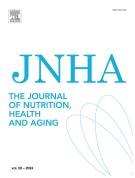Dietary inflammatory index, dietary total antioxidant capacity, and frailty among older Chinese adults - 11/02/24
 , Yi Zhao a, b, c, ⁎
, Yi Zhao a, b, c, ⁎ 
Abstract |
Objectives |
Frailty is an age-related syndrome associated with poor health outcomes. Studies in developed countries indicate that the dietary inflammatory index (DII) and dietary total antioxidant capacity (DTAC) are important dietary factors influencing the risk of frailty in older adults. However, few studies have explored the association between DII, DTAC, and frailty among older Chinese adults. The objective of the current study was to examine whether DII and DTAC were associated with pre-frailty or frailty among older Chinese adults.
Design |
A cross-sectional study.
Setting |
Community-based.
Participants |
We included 6414 participants aged ≥60 years.
Measurements |
Dietary intake was assessed using a validated food frequency questionnaire (FFQ). The DII and energy-adjusted DII (E-DII) were calculated using food parameters. DTAC was estimated using two widely adopted antioxidant scores: DTAC based on ferric reducing antioxidant power and dietary antioxidant quality score (DAQS) obtained from vitamins (vitamins A, C, and E) and minerals (zinc and selenium) with antioxidant functions. Frailty was assessed using the frailty index (FI) calculated from 28 health-related deficits. Individuals were classified as robust (FI ≤ 0.10), pre-frailty (FI > 0.10 to <0.25), or frailty (FI ≥ 0.25). Multiple logistic regression models were used to evaluate the associations of DII and DTAC with pre-frailty and frailty.
Results |
After adjusting for confounding factors, individuals in the highest DII quintile (Q5) were more likely to have pre-frailty (odds ratio [OR] = 1.56; 95% confidence interval [CI]: 1.25–1.93; P for trend <0.001) than those in the lowest Q1. A similar positive association was detected for E-DII and pre-frailty. A significant association was found between DII and frailty. Compared with the lowest Q1, the highest Q5 of DTAC was negatively correlated with pre-frailty (OR = 0.66; 95% CI: 0.52–0.84; P for trend <0.001) and frailty (OR = 0.71; 95% CI: 0.50–0.1.03; P for trend <0.001). The DAQS yielded results similar to pre-frailty results (OR = 0.72; 95% CI: 0.58–0.89; P < 0.001). There was no evidence suggesting an association between DAQS and frailty.
Conclusions |
More proinflammatory diets were linked to higher pre-frailty risk, whereas higher levels of dietary antioxidants were associated with lower pre-frailty and frailty risk among older Chinese adults.
Le texte complet de cet article est disponible en PDF.Keywords : Frailty, Frailty index, Dietary inflammatory index, Dietary antioxidants, Older adults
Plan
Vol 28 - N° 4
Article 100168- avril 2024 Retour au numéroBienvenue sur EM-consulte, la référence des professionnels de santé.

